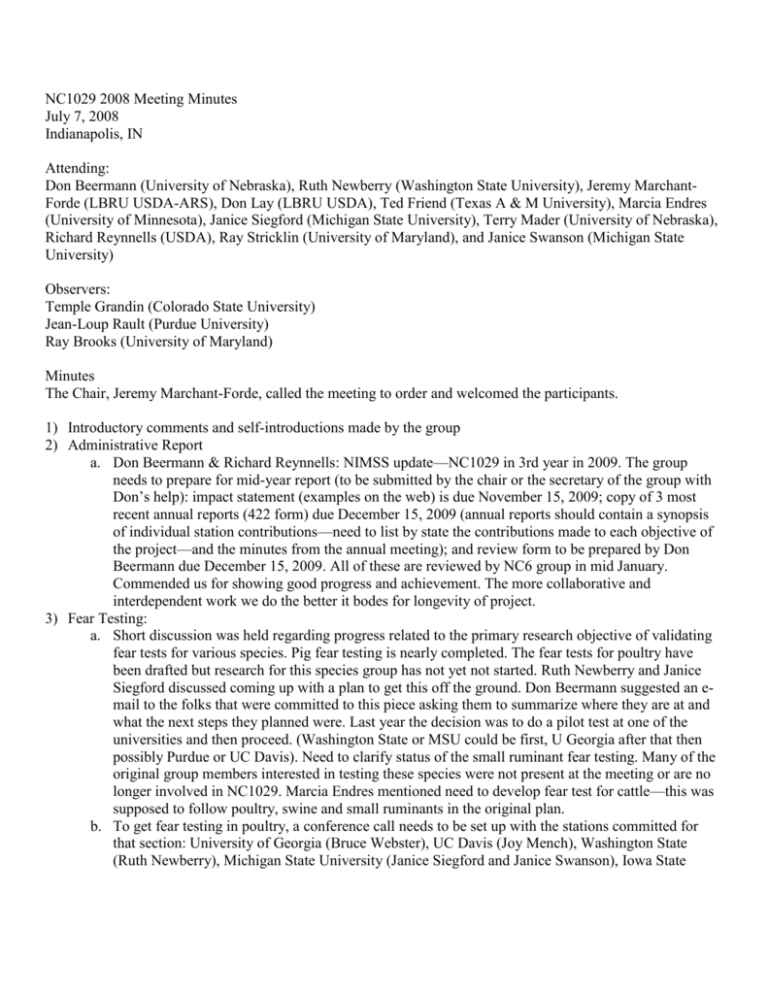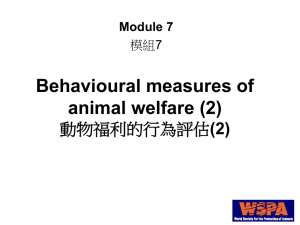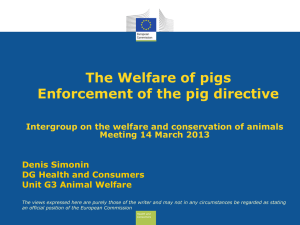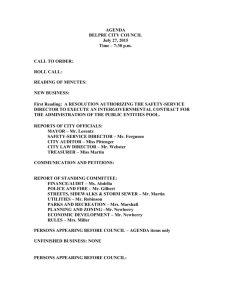NC1029 2008 Meeting
advertisement

NC1029 2008 Meeting Minutes July 7, 2008 Indianapolis, IN Attending: Don Beermann (University of Nebraska), Ruth Newberry (Washington State University), Jeremy MarchantForde (LBRU USDA-ARS), Don Lay (LBRU USDA), Ted Friend (Texas A & M University), Marcia Endres (University of Minnesota), Janice Siegford (Michigan State University), Terry Mader (University of Nebraska), Richard Reynnells (USDA), Ray Stricklin (University of Maryland), and Janice Swanson (Michigan State University) Observers: Temple Grandin (Colorado State University) Jean-Loup Rault (Purdue University) Ray Brooks (University of Maryland) Minutes The Chair, Jeremy Marchant-Forde, called the meeting to order and welcomed the participants. 1) Introductory comments and self-introductions made by the group 2) Administrative Report a. Don Beermann & Richard Reynnells: NIMSS update—NC1029 in 3rd year in 2009. The group needs to prepare for mid-year report (to be submitted by the chair or the secretary of the group with Don’s help): impact statement (examples on the web) is due November 15, 2009; copy of 3 most recent annual reports (422 form) due December 15, 2009 (annual reports should contain a synopsis of individual station contributions—need to list by state the contributions made to each objective of the project—and the minutes from the annual meeting); and review form to be prepared by Don Beermann due December 15, 2009. All of these are reviewed by NC6 group in mid January. Commended us for showing good progress and achievement. The more collaborative and interdependent work we do the better it bodes for longevity of project. 3) Fear Testing: a. Short discussion was held regarding progress related to the primary research objective of validating fear tests for various species. Pig fear testing is nearly completed. The fear tests for poultry have been drafted but research for this species group has not yet not started. Ruth Newberry and Janice Siegford discussed coming up with a plan to get this off the ground. Don Beermann suggested an email to the folks that were committed to this piece asking them to summarize where they are at and what the next steps they planned were. Last year the decision was to do a pilot test at one of the universities and then proceed. (Washington State or MSU could be first, U Georgia after that then possibly Purdue or UC Davis). Need to clarify status of the small ruminant fear testing. Many of the original group members interested in testing these species were not present at the meeting or are no longer involved in NC1029. Marcia Endres mentioned need to develop fear test for cattle—this was supposed to follow poultry, swine and small ruminants in the original plan. b. To get fear testing in poultry, a conference call needs to be set up with the stations committed for that section: University of Georgia (Bruce Webster), UC Davis (Joy Mench), Washington State (Ruth Newberry), Michigan State University (Janice Siegford and Janice Swanson), Iowa State 4) 5) 6) 7) University (Suzanne Millman and Anna Johnson), and Purdue (Joe Garner). The conference call can be run through Rich Reynnells at USDA so that we can use an 877 number. Animal Welfare Courses: a. How do to multi-university collaborations work? The group talked about existing course and collaborations (MSU/Guelph/Purdue and Illinois/Iowa/Texas Tech). Collaborations do not need to be limited to collaborators in adjacent states if teaching collaborations can be done in a distance education fashion. The creation of entire courses, modules or guest lecturing could be options for fostering collaborative efforts of varying degrees. b. In order to make this a group priority, we could write the creation and sharing of a collection of courses as an objective for NC1029—though participation in such a venture wouldn’t be limited to the members of NC1029. c. Don Beermann mentioned that course material on institutional animal care and use (rules, legislation, etc) could be a possible topic which most research students need to know more about. d. Ruth Newberry talked about using online or distance video to capture lectures on material we already have prepared or courses or lectures we already teach. e. Ted Friend was in agreement and suggested creating a list of possible lecturer names and the topics they’d be willing to deliver (and also at what level). In this way contributors can donate material they have already created and may not have to develop any new material. Animal Behavior and Well-Being ASAS/ADAS committee: any symposia or topic ideas from our group for 2009? Ted Friend is the chair this year (and Jeremy Marchant-Forde is on the committee) and could submit the idea to the committee. a. Ruth Newberry suggested a symposium on fear, measurements and fear-related assessments. b. Ted Friend said that a paper or symposium would be fine since a whole symposium may be tougher. Ted will propose it to the joint committee when they meet on July 8, 2008. c. The pig fear testing research results should be ready to present next year—also Joy Mench has some goat research in this area and Ruth Newberry has some poultry fear test data. We could look for an international speaker for cattle (for example, someone from INRA to talk on fear in dairy calves). d. Ruth Newberry suggested focusing on pigs with possible components of anxiety, startle and fear response. We should also have shorter research talks in addition to longer talks by 1-2 invited speakers. e. In addition to NC1029 speakers, a potential international speaker could be solicited on the topic related to assessing fear of pigs on farm by the EU. f. Ted Friend suggested a review of the rodent or other livestock literature as a possible paper too in order to provide background and comparison to set the stage for the subsequent papers. g. Terry Mader also suggested something revolving around the revision of the FASS guidelines since there will be some pretty substantial revisions. Animal Behavior vs. Animal Welfare Discussion a. Ray Stricklin says we should focus primarily on making animal behavior a stand-alone scientific discipline that is distinct from animal welfare. If we combine welfare and behavior then we muddle the scientific behavior work by throwing ethical issues into the mix. All animal-based disciplines should deal with animal welfare, not just the behaviorists. Ray Stricklin thinks that welfare should sit more with the bioethics committee than with the behavior group. The discipline of behavior would be elevated by standing it on its own rather than muddling it in with welfare. Station Reports a. Marcia Endres, University of Minnesota: i. Maternal fear in sows (Y. Lee’s project): 91 sows and gilts. She collected production data and conducted fear tests (novel object and novel human) on all sows in the study. She is currently doing regression analysis to see how the fear scores relate to piglet mortality. Video of sows and litters for first 3 days after farrowing will be analyzed. The major question is how to reduce mortality in loose farrowing systems? ii. Marcia Endres is currently looking at low-profile cross-ventilated free stall barns and how these housing facilities affect productivity and welfare in dairy cows. She is looking primarily at lameness as a welfare measure and also recording production measures. Compost barns, low-profile cross-ventilated barns and naturally ventilated barns are the 3 treatment types. All are sand bedded stalls. She is collecting production data from cows on all farms. On a subset of farms, cows are being followed from calving through lactation for lameness scoring as well (visual locomotion scoring), cow cleanliness, cow hygiene, and body condition score. Also will be examining lying time in summer and winter (3x/season on each farm, 40 cows/farm) in the future. There may be problems with low light and dampness in the cross-ventilated barns. b. Jeremy Marchant-Forde, USDA ARS LBRU: i. Heng-wei Cheng & Jeremy Marchant-Forde are full-time on animal well-being. Don Lay and Susan Eicher are 2/3 each on animal well-being and 1/3 on food safety. Marcos Rostango is full time food safety. There are also numerous support staff (technicians, support scientists, undergrads and graduates) working in animal behavior and well-being. ii. NC1029 pig fear tests were all completed at the USDA last year and data are with Joe Garner for analysis. iii. Pigs 1. Sow exercise & lameness (Erin Schenck)—completed a. 60 gilts, 8 mo of age in 3 treatments: control (no exercise), low exercise (3days/week), high exercise (5 days/week). Exercise consisted of walking around the barn on a concrete surface. The most important element of the exercise is intensity not really distance. b. Exercise did not decrease lameness (all groups had low levels of lameness). Pigs in all groups had damage to musculo-skeletal systems (i.e., cartilage was already showing wear in all groups). c. Exercise did improve bone breaking strength and piglet survival (which may have been due to an effect on lying time with exercised sows lying down faster). Sows that exercised seemed to crush fewer piglets. 2. Ractopamine & intestinal microbial populations (Rosangela Poletto)—completed a. No salmonella detected in ractopamine-treated pigs b. Ractopamine (given in step-up dose from 4.5g/kg to 9g/kg) generally increased enterobacteriaceae levels during rearing but not at slaughter c. Ractopamine increased hoof lesions of all sorts (cracks, splits, bruising 3. Aggression in finishing pigs & ractopamine (Rosangela Poletto, talk at ASAS)—in progress a. Aggression increases in ractopamine fed pigs, particularly in gilts at the finishing stage that are in stable groups. 4. Heart rate variability as a welfare indicator (Don Lay)—in progress 5. Aggression in sows (Jeremy Marchant-Forde)—in progress a. Basic work looking at behaviors when introduced singly and in pairs (talk at ASAS) i. Mixing sows one-on-one and looking at behavior in detail to see if we can predict whether aggression will happen. What behaviors predict aggression? Can you influence these behaviors to limit or avoid aggression? ii. If you look at the 20 behaviors prior to mixing, there are differences in the situations where aggression ends up happening. If the second sow in the encounter doesn’t respond to an overture by the first sow, there is an increase the chance of subsequent aggression. If the second sow responds with nose-to-nose contact, then aggression is less likely. b. Pre-exposing sows prior to mixing (NPB grant) 6. HPA axis function and abnormal behavior (Don Lay, poster at ASAS) a. Dexamethasone suppression test followed by cortisol (after baseline) then sample 12h later. There is resistance to suppression in abnormal humans, so the same thing is expected in sows performing abnormal behavior. b. Don is looking at sows performing different amounts of abnormal behavior to determine if there are differences in HPA regulation that would parallel what happens in humans. c. 23 sows showed cortisol suppression as expected, but 4 did not. There was no real relationship between suppression and abnormal behavior. 7. PigTurn continues to develop to allow for collection of other data (Jeremy MarchantForde). iv. Poultry (Heng-wei Cheng) 1. Alternative strategies for molting 2. Beak (hens) and bill (ducks) trimming work, with Joy Mench and Ed Pajor 3. Aggression a. Investigating links between serotonin and aggression in different genetic strains. Injecting different serotonin antogonists into subordinate birds b. See increase in aggression in mean birds with the 5-HT1 antagonist c. See increases in feather pecking differently depending on antagonist in mean vs kinder birds 4. Chronic (housing) & acute (transport) stress a. HGPS (kinder) birds seem to have a better coping response to transport stress 5. Early development and stress (using pre-hatching stressors) v. Dairy (Susan Eicher) 1. Lameness and flooring in dairy cows a. Concrete vs rubber floorings, followed heifers through 2 lactations b. More heifers housed on concrete were culled in the first year due to joint related problems c. Data collection included immunological measures, microarray, cortisol, locomotion scores, behavioral observations 2. Transport stress in calves and yeast products 3. Molasses consumption and stress a. Chronic intermittent stress increases endogenous glucose drive resulting in increased molasses consumption i. Isolation and regrouping were used as the chronic intermittent stresses b. Measuring behavior, cortisol, and immunological measures c. Janice Siegford, Michigan State University i. Faculty working in animal behavior and welfare: Janice Swanson (professor, director of animal welfare, Janice Siegford (assistant professor, animal behavior & welfare), and Camie Heleski (instructor/coordinator of 2yr horse management program, equine behavior & welfare) ii. Janice Swanson highlighted forthcoming opening of another position at MSU. Search Committee will be formed in the Fall. Position description/level is not certain at this point. iii. Research 1. J Swanson: American Egg Board project looking at a system wide approach to laying hens (leading toward USDA CAP) 2. J Siegford a. Swine fear testing (done 5/08) as part of NC1029 b. Using social facilitation to encourage beef calves to consume grain more readily at weaning. c. Correlating of temperament, maternal behavior, phenotype and genotype in beef cattle. d. Developing bird-mounted activity monitors to monitor activity, social interactions, and resource use in non-caged poultry. 3. C Heleski a. Rein tension study to examine whether martingales affect pressure on reins by beginning riders and whether that relates to stress behaviors and frame scores in horses b. Rider pressure distribution iv. Teaching 1. Ethics in Animal Agriculture: Undergraduate, face-to-face, Swanson 2. Animal Welfare Assessment: Graduate, online, Siegford 3. Applied Animal Behavior: Undergraduate, face-to-face, Siegford 4. Introduction to Animal Welfare Assessment: Undergraduate, face-to-face, Heleski 5. Animal Welfare Judging: Undergraduate, face-to face, Heleski 6. Horse Behavior: Undergraduate, online, Heleski 7. Animal Welfare Science and Society (in development): Undergraduate, online, Siegford v. Animal Welfare Judging Competition 1. Hosted 2008 Competition, March 2008. Camie Heleski organized. Judges were Ray Anthony, Chris Chandroo, Ed Pajor, Steve Halstead, Aaron Moore, & Txema Peralta. Species covered were dogs, sow housing, & aquaculture. A vet student division was introduced for the first time and students from Atlantic Veterinary College on PEI won this division. 2. Next competition: November 1-2, 2008, MSU. A graduate student division being added to this competition. Species to be covered will be cats, dairy, and Prezwalski horses for the individual assessment. The team problem will be a live assessment of several poultry species. d. Ruth Newberry, Washington State i. Personnel : Ruth Newberry (poultry & pigs), Jaak Panskepp (affective states), Sylvie Cloutier (lab animals) ii. People Pet Partnership director position to be opening this fall to fill the vacancy left by Francois Martin moving to Purina 1. The position will have a research component in social neuroscience iii. Zoo animals 1. MS student under Ruth just finished who was working in captive clouded leopards— low fecal corticosteroids indicate better reproductive success iv. Poultry 1. Ruth is finishing a big study on cannibalism in laying hens a. Looking at dopamine and their agonists/antagonists and the role in this (Ragen Trudel McGowan Schwartz) 2. Ruth Newberry is heavily involved in UEP Welfare Committee—things are going to be crazy this year due to upcoming referendum in CA that could eliminate cages in that state a. UEP released recommendations for non-cage housing last year, but implementation and auditing is going to be tough 3. Ruth Newberry is also involved in AEB project with Janice Swanson. This is a holistic project that integrates well-being, animal and human health, carbon foot print 4. Also involved with automated hen monitoring project at MSU 5. Involved in UBC project looking at genotype and behavior interactions in different housing systems among 3 strains 6. Play behavior and future fear and anxiety in chickens. The birds with the most play experience are the most fearful when separated from the group in an open field. Could be a problem with the tests. How do you interpret open field tests in chickens? Play = worm running and interaction over the worm? Handling and novel object didn’t show much. Tonic immobility may have some relationship, but again maybe not in predicted direction. v. Mice & Rats 1. How much work mice do to access opportunities to contra-free load? 2. Influence of positive handling on responses when exposed to stress tests like elevated plus maze, cat scent, etc. Tickling seems to have positive effects—this simulates social play between rats. Petting doesn’t work. Very clear reduction in latency to approach human hands if you tickle rats a lot. 3. Factors affecting depression in rats (and degus) and relation to play behavior and subsequent development of depression. vi. Dogs 1. Aggression and returns to shelter vii. Pigs 1. Needs equipment to be able to conduct NC1029 fear tests. Iowa State is just finishing up and should be able to send it along. 2. Communication of alarm behavior using playbacks of barks to see responses of other pigs—this might be a nice signal to use for the fear tests instead of air horns. (Don Lay said they saw no response when they did these types of sounds to stalled gestating sows.) 3. Strength of filial attachment bonds of piglet to mother using isolation and reunion responses to measure, particularly how much vocalization occurs at these time points (ISAE talk this summer, published in Developmental Psychobiology) viii. Teaching 1. Rights & Welfare (Newberry) 2. Affective Neuroscience (Panksepp) 3. Reverence for Life (Cloutier) 4. Grad course for neuroscience graduate students: soul self-awareness & sexuality (they will have a video link for this if we have any graduate students that want to link in) e. Terry Mader, University of Nebraska i. Research: Describing apparent temperature—how do you adjust an ambient temperature to describe what the temperature feels like to the animal/human? 1. Relative humidity (under hot and cold conditions), windspeed, and radiation (solar and surface) are all components 2. Relative humidity makes high temperatures hotter and cold temperatures colder 3. Windspeed increases temperature if wind is below a certain speed but decreases temperature above a certain speed 4. Solar radiation correction varies according to temperature—there is more correction needed at cold conditions than at high temperatures 5. Surface radiation correction is parallel for different temperatures 6. New model combines correction for solar and surface radiation and then the humidity and wind speed to come up with an apparent temperature that reflects what is actually felt. 7. The upshot is that ideal range is between index values 41F and 70F. By the time the temperature is 77F, the animal is starting to show heat stress. Animals are better adapted to deal with cold stress. 8. Then new index (CCI) determines apparent temperature, has enhanced sensitivity, adjusts for relative humidity, accounts for windspeed effect, and accounts for solar and surface and solar radiation. 9. Has software that can allow you to calculate this for your parameters either on an hourly or daily basis. f. Ray Stricklin, University of Maryland i. Personnel 1. Inma Estevez has departed for a position in Spain 2. The Department has carried out 3 searches for Assistant Professor, but has not appointed anyone. Conflict between search committee and faculty in terms of what is expected of the person filling the position. ii. Ongoing research 1. Kim Durnick, DVM is researching use of EEG in cattle 2. Ray Brooks, looking at movement patterns in mice to determine use of space. Results indicate that a 2 x 3 rectangle is the shape with the most ‘useable’ space g. Richard Reynells – CSREES 1. Tries to keep everyone updated on a weekly basis via email mailing lists, so has nothing specific to add at this meeting. 2. Only thing of note is the result of the Agriculture Bill and the formation of the NIFA that means combination of CSREES and ARS. At this point it is thought that there will not be much change in terms of personnel, except maybe a new scientific director. 8) Business Meeting: Elect Officers for 2008-2009 a. As per NC1029 bylaws, the current Secretary will become this year’s Chair. Don Lay nominated and Ruth Newberry seconded Janice Siegford. A vote was taken and was unanimous. b. Ruth Newberry was nominated as Secretary by Marcia Endres and seconded by Don Lay. A vote was taken and was unanimous. Next year’s venue. It was discussed that next year’s meeting may be organized to run in conjunction with the North American regional meeting of the ISAE, which itself will be run in conjunction with ASAS/CSAS in Montreal. Stephanie Torrey and the Michigan State group will be working together to organize the NA ISAE meeting. Any other business 1) Discussion of the Future Trends meetings held in DC and organized by Rich Reynells. Attendance is decreasing and HSUS/AWI are now not participating. It was suggested that maybe an NC-1029 organized meeting, held in D.C. could replace the Future Trends meeting for one year, to increase our impact and profile. 2) Discussion on the slaughter horse welfare issue. The meeting was then adjourned.









